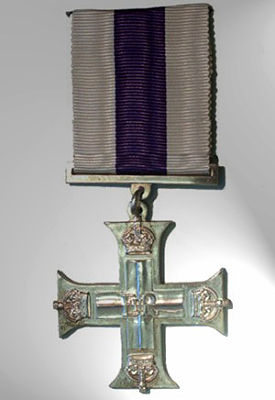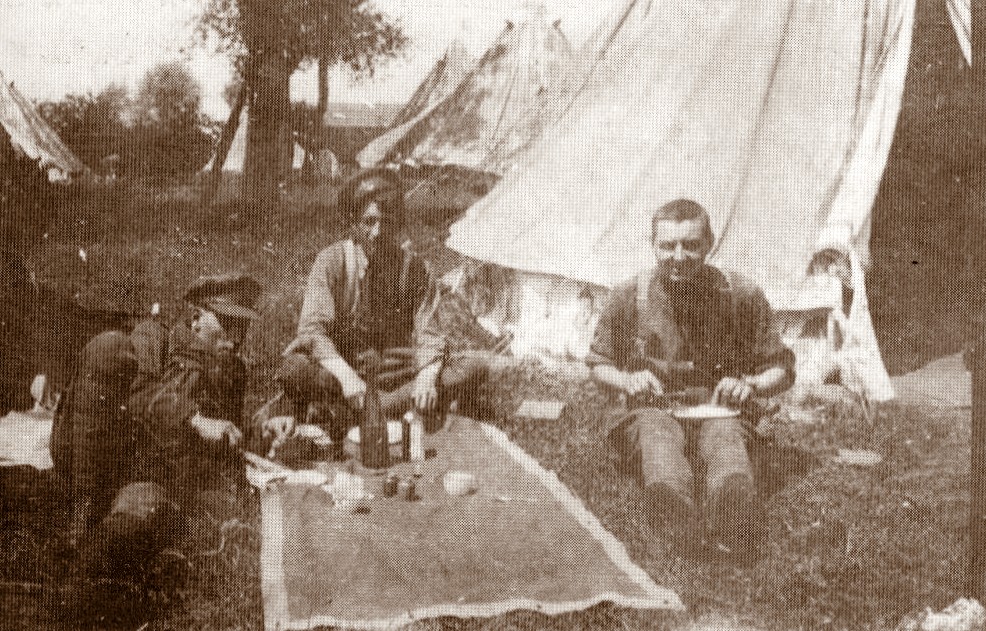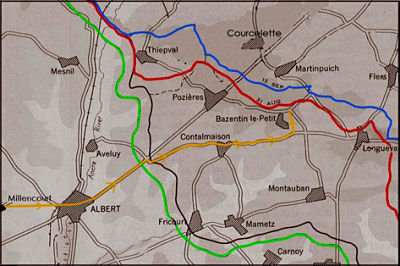
Between the 7th and 17th August 1916 the 4th Battalion moved from Kemmel to Millencourt, a village
just West of Albert in the Somme department.
They travelled by train from Bailleul to Doullens.
The rest was foot slogging by a roundabout route,
with terrible conditions at the Camps in between.
|
10th AUGUST.
4282 Pte Speechley Robert. Home at 12 William St, North Skelton in Cleveland and
enlisted at Saltburn, N Yorks. Killed in action. Age 22. Buried at Quarry Cemetery, Montauban.
[CWGC site gives 4th Bn and this date.]
11th AUGUST. "The train left Bailleul at 4.28 a.m and arrived at Doullens about 10.30. No preparations
had been made here for the arrival of troops. There were no sanitary arrangements and no supply of water.
The Bn moved to a field on the outskirts of the town and rested there until dinners were cooked.
Moved then by road via Fienvilliers to Bernaville - 15 kilometres into Billets. No arrangements had been made to
transport men who were unfit to march and on arrival there was no hospital to which men could be evacuated."
12th to 14th AUGUST. The Bn stayed at Bernaville. Digging latrines, erecting wash places. Inspection and
route marching carried out.
15th AUGUST. "The Bn left Bernaville at 4.15 a.m. The Brigade moved together with first line transport behind
each Battalion.
The billets at Flesselles left everything to be desired, being inadequate and filthy. Heavy
showers of rain afternoon and night."
16th AUGUST. The Brigade moved from Flesselles to a wood east of the village of Mulliens Au Bois.
Great inconvenience had been caused to troops on the march on each occasion when moving along the narrow lanes by
strings of buses containing various Headquarter, Clerks, Sanitary sections etc etc. These left the starting point
after Brigades and came through them. In every case wherever the Battalion was billeted or bivouaced no latrine
accommodation was available on arrival. The Divisional sanitary section could easily have prepared this beforehand
and thus relieved tired troops.
17th AUGUST. "The whole Brigade moved to Millencourt, moving off at 4.15 a.m and reaching there at 8.15 a.m.
As usual no preparations had been made for its arrival and the Brigade was billeted where previously 2 Battalions
had been.
|

The Military Cross.
Awarded to Officers and Warrant Officers for gallantry during active operations
against the enemy.
Awarded to Regimental Sergeant Major J.W. Wilkinson.
|
Throughout the whole of the move the Ambulance [Field Hospital] arrangements were bad and the greatest trouble
was experienced in getting men unfit to march from one place to another. Messengers had to scour the country for Field
Ambulance so that dangerously ill men could be evacuated and Ambulances refused to take patients because they were
attached to another Brigade."
18th AUGUST. Diary - The training of the Battalion commenced. A growing disposition is continually shown
by the higher command to interfere with the training of a Battalion and to alter a system for unnecessary and
inconsidered trifles. On the other hand Battalions have invariably to scour the country for suitable sites for
training and rifle ranges which could with great ease have been done for them.
19th to 23rd AUGUST. "Training and drill. A firing range was built. An exercise was carried out during which
it was observed that Junior Officers did not show great signs of training in the Field previous to being sent to join
this Regiment."
On the 22nd one of these Junior Officers, 2nd Lt Ewart Richardson wrote home to his mother:-
”Sooner or later out here I am nearly certain to have to face dangers much more heavy than anything I've met up to now. I may go under.
That's a fact to be recognised as coolly as may be. If I do, my lot's nothing like so hard as that of these boys of 19 and 20 who are wiped
out in this senseless holocaust. But I don't feel as if I shall.”
He would be killed on the 27th of the following month.
24th AUGUST. The Brigade did a practice attack. There was considerable muddle due to wrong map
references being given in Op Orders. Also from lack of training of the troops, ground which could not be crossed
over owing to crops etc and the great slowness with which troops for the assault of the second position advanced.
2nd Lts Minister, Harrison and Omand joined the Battalion.
25th AUGUST. Diary - The health of the Battalion is bad. The billets are bad, overcrowded and unhealthy.
Medical stores cannot be obtained in sufficient quantities. Fever and diarrhoea are increasing. Flies are present
in clouds and for the first week of the stay at these billets butter muslin was unprocurable. The whole of the
Medical arrangements have been bad and sufficient care has not been taken of the troops.
|

Officers of the 4th Yorks. No one identified. According to "The Somme" by R Van Emden, from which the photograph was taken, all were killed in the following months.
|
26th to 31st AUGUST. More training. Practice attack with an aeroplane for spotting purposes.
3 Battalions took the first objective and signalled their position to the aeroplane which reported to Bde Hq
with smoke bombs to inform Brigadier of the position of the flanks. Musketry for backward men.
Lt Thornton rejoined from Kite Balloon Section R.F.C. and 2nd Lt F E Postill joined the Bn.
The Diary is signed off by Lt Col F.F. Deakin.
1st to 9th SEPTEMBER.
2nd Lt James Leslie Roberton 4th Battalion and Royal Flying Corps. The youngest son of Robert Hopkins Roberton JP and his wife
Mary Louisa of Stoke Golding Lodge, Nuneaton.
He born at Stoke Golding Lodge on September 7th 1894 and educated at Magdalen College School in Oxford.
In the spring of 1913 he travelled to South Africa to study farming. Deciding agriculture was not for him he returned to England in 1914 and
enrolled at London University as a medical student where he was also a member of the Officer Training Corps.
He was was commissioned into the Yorkshire Regiment on August 12th 1915 and for a time was machine gun instructor with the 4th battalion
before transferring to the Royal Flying Corps in April of 1916 and gaining his pilots certificate on August 11th 1916.
Patrolling the lines between Hulloch and Lens on September the 6th 1916, he was attacked by a Fokker, crashing to the ground where his
petrol tank exploded. He as killed in this incident aged just 21. He is remembered today on the Arras Flying Services Memorial at the
Faubourg D’Amiens Cemetery in Arras.
Training continued with more evidence of gross neglect of the men's welfare and lack of communication with higher command.
|

On the 10th Sep 1916 the 4th Yorks Battalion left Millencourt for the Trenches in front of Bazentin Le Petit.
The Battle of the Somme had been raging since the 1st July, when the front had been at the green line.
By the 31st August the Germans had been pushed back to the red line, but only at the expense of severe
losses.
The 50th Division had been ordered to take over the Front line to the North and North East of Bazentin Le Petit.
On the 15th of September the Battle of Flers-Courcelettes started with the Front shown by the blue line.
|
This was stated by the Commanding Officer of the Battalion. The opinion of the other ranks can be imagined.
Diary - A party of men supplied each day to help to build Divisional Headquarters. No material of any kind
was available for making latrines etc for the men. Vast quantities of material were used for the Divisional HQ.
Scheme - The Division in the Attack - The objective was marked by men standing on the line of a supposed Trench.
As these had either disappeared or were asleep when the assault took place the result was chaotic. No written
orders were received and only verbal message given. Starting points, lines of barrages etc were received at odd
moments during the proceedings.
10th SEPTEMBER. The Btn left Millencourt and proceeded into Bde Support at Shelter Wood. Old German dugouts
were available for Btn and Coy HQs. Men bivouaced in the wood. On arrival it was found that the area allotted was
occupied chiefly by troops of another Division.
Divisional History - "For sheer tragedy, wholesale destruction, the first vision of that ghastly battlefield almost
blotted out from one's mind memories of the Ypres Salient. So battered and blasted by our gunfire was the old
No Mans Land of pre-July that it was hardly distinguishable. Lozenge and Shelter Woods were two of a cluster
North of Fricourt. The Quadrangle was about five hundred yards south-west of Mametz Wood, the latter presenting
a truly terrible appearance. Bitter fighting had taken place for the possession of the Wood and Contalmaison
village to the West of it. Swept by an awful holocaust of shell fire, first by the British guns and then by the
German Artillery on the Wood passing into our hands, it had become a place of evil repute - worse even to live in
for beneath and
|
among the broken and lacerated trees men had their habitation in tents or had burrowed into
the ground - anywhere as shelter from the enemy's guns which still kept the place under furious bombardments.
The route now led across shell-torn country, pock marked and broken with countless craters. Tangles of barbed
wire tossed and flung about in endless confusion were everywhere. Bazentit Le Petit stood on high ground,
beyond which in a small valley were the trenches to be taken over. There was no mistaking them, for they were
covered by wreaths of evil black smoke from bursting shells, punctured every second or so by sharp stabs of
flame as explosion succeeded explosion and fountains of earth and debris shot up into the sky."
11th SEPTEMBER. 200 men worked at cable trenches in the morning and carrying stores to the forward dumps at
night. Most of these men could have been rested if the old German tramway had been repaired.
12th and 13th SEPTEMBER. At night 200 men were employed in deepening the existing new advance line
and digging an assembly trench 30 yards behind the front line. Commenced making Dressing Station and Dump in strong point
between Swansea Trench and Eye trench in Somme Alley Extension. There was a considerable amount of hostile
shelling which was fortunately just behind the assembly trench.
|
|



